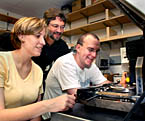Inside Iowa State | ||
Inside ArchivesSubmit newsSend news for Inside to inside@iastate.edu, or call (515) 294-7065. See publication dates, deadlines. About InsideInside Iowa State, a newspaper for faculty and staff, is published by the Office of University Relations. |
June 11, 2004 Fast track to materials discoveriesby Debra Gibson Consider it the Martha Stewart method of conducting scientific experiments -- an exceedingly efficient system of analyzing materials that reaps tens, if not hundreds, more results than a typical test, and in a fraction of the time. Researchers prefer to call it combinatorial science, a university initiative that has distinguished itself among the top priorities at Iowa State and has spawned the Institute for Combinatorial Discovery (ICD). Under the direction of Marc Porter, chemistry professor, the institute encompasses 34 faculty members across campus, representing 12 departments, five colleges and several centers. Their disparate specialties notwithstanding, the scientists all share the same long-range vision: to elevate the combinatorial science program at Iowa State to eminent international stature. All are involved in a science methodology that, at its simplest, accelerates discoveries. Experiments to test and screen thousands of materials are run in a parallel fashion, rather than the more traditional "one at a time" approach. "We want insights into how materials work," Porter explained, "how to design these materials and make them run better. Blending two different metals may not result in anything, but if you mix them in different proportions, maybe they will. So you have these areas of vast search space, and you mix A and B in infinite proportions, and then take a look at the combinations that are the hottest." The pharmaceutical industry has utilized this protocol for several years in developing new drugs, creating countless chemical combinations at one time to determine successful molecular arrangements. "The pharmaceutical industry already is spending billions for this type of research," Porter explained, "so for us, that train has left the station. We kept asking what it is that Iowa State can do for industry in combinatorial science research that isn't already being done." Eventually, the areas of specialization were narrowed to:
Scientists will depend heavily on many research tools to accomplish these projects, including informatics, robotics and high throughput instrumentation. They also rely on access to such cutting-edge campus facilities as the Roy J. Carver Laboratory for Ultrahigh Resolution Biological Microscopy and the W.M. Keck Laboratory for the Fabrication of Microminiaturized Analytical Instrumentation. Funding for the initiative has come from the university (for four full-time faculty positions), and from such organizations as the National Institutes of Standards and Technology. However, it is the hope of Porter and his colleagues that the institute be awarded the prestigious National Science Foundation Science and Technology Centers grant, which would provide $20 million over five years beginning next year. For the first time, ISU has been invited to submit a full proposal for this award, becoming one of 38 institutions chosen from more than 160 applicants. Until then, Porter and his colleagues continue to pursue partnerships with industries hungry for the university's combinatorial research results. And the Iowa State scientists take seriously their role in including students in their research efforts to better prepare them for industrial careers. To further this mission, the institute is working closely with U.S. historically black colleges and universities in diversity, recruitment and knowledge transfer efforts. "What we're doing here has implications for many," Porter said. "Our research is important to industry, but companies can't afford to invest in doing the research themselves. We can tackle the work with our graduate students, giving them growth experiences and advancing science, all at the same time." |

Professor Marc Porter (center), who directs the Institute for Combinatorial Discovery, checks out the work of graduate students Amy Sywassink Determan and Grant Edwards as they operate an atomic energy microscope in Spedding Hall. (Photo by Bob Elbert.) Quote"Our research is important to industry, but companies can't afford to invest in doing the research themselves. We can tackle the work with our graduate students, giving them growth experiences and advancing science, all at the same time." Marc Porter |
|
Ames, Iowa 50011, (515) 294-4111. Published by: University Relations, online@iastate.edu. Copyright © 1995-2004, Iowa State University of Science and Technology. All rights reserved. |
||